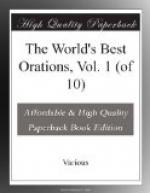“The evidence in support of a conspiracy is generally circumstantial” (Russell on Crimes, Vol. ii., 698.)
In regard to circumstantial evidence, all the best and ablest writers, ancient and modern, agree in treating it as wholly inferior in cogency, force, and effect, to direct evidence. And now for the rule that must guide the jury in all cases of reasonable doubt:—
“If evidence leave reasonable ground for doubt, the conclusion cannot be morally certain, however great may be the preponderance of probability in its favor.” (Wills on Circumstantial Evidence. Law Library, Vol. xli.)
“The burden of proof in every criminal case is on the government to prove all the material allegations in the indictment; and if, on the whole evidence, the jury have a reasonable doubt whether the defendant is guilty of the crime charged, they are bound to acquit him. If the evidence lead to a reasonable doubt, that doubt will avail in favor of the prisoner.” (1 Greenleaf, section 34—Note.)
Perhaps one of the best and clearest definitions of the meaning of a “reasonable doubt” is found in an opinion given in Dr. Webster’s case by the learned and accurate Chief-Justice of Massachusetts. He said;—
“The evidence must establish the truth of the fact to a reasonable and moral certainty; a certainty that convinces and directs the understanding and satisfies the reason and judgment of those who are bound to act conscientiously upon it.” (Commonwealth versus Webster, 5 Cush., 320.)
Far back in the early history of English jurisprudence we find that it was considered a most serious abuse of the common law, “that justices and their officers, who kill people by false judgment, be not destroyed as other murderers, which King Alfred caused to be done, who caused forty-four justices in one year to be hanged for their false judgment. He hanged Freburne because he judged Harpin to die, whereas the jury were in doubt of their verdict; for in doubtful cases we ought rather to save than to condemn.”




